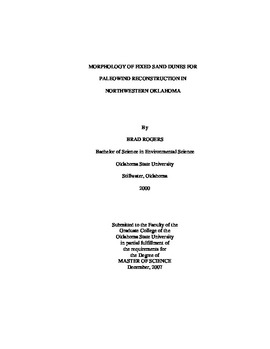| dc.description.abstract | This study selected five areas of visible dune topography along the Beaver River and Cimarron River in Cimarron County, Beaver County and Woods County by using existing maps, digitized aerial photos (NAIP images), and digital soil surveys. Sand dune crests were manually mapped over the digitized aerial photos in ArcGIS. Wind vectors were inferred were from mapped crests to establish wind directions at the time of dune formation. Relative age was established by assigning generation numbers to dune fields based on visible forms and vegetation development. The corroboration of this relative age was performed using a combination of soil series and vegetation associations as well as visible erosion on dunes. Each generation comprised a period of major eolian activity, presumably resulted from a dry phase. Paleowind directions obtained from stabilized sand dunes in northwestern Oklahoma show a consistent direction from the northwest and the southwest. In all of the study sites, except site C and the currently active dunes of Site E, the mapped paleowind directions concentrate in the northwest quadrant. Site C large dune crests had a higher occurrence of SW orientation in total.. These dunes, however, appear still active in aerial photographs as late as 1966, and a few in 1995. The active dunes at Site E (Generation 4), which are modern dunes and not paleodunes, follow the patterns of the modern wind roses, whose main direction is south and southwest, and to a lesser extent northwest. The modern winds show a stronger vector from the south and less from the southwest, except for Cimarron County, where the southwest component is more prominent than the southern component. The paleowind directions obtained from map dunes show a high tendency to directions from the NW. This suggests that during periods of prolonged drought, which derive in eolian activity, winds are more likely to blow from the northwest, while still important from the south and southwest. | |
